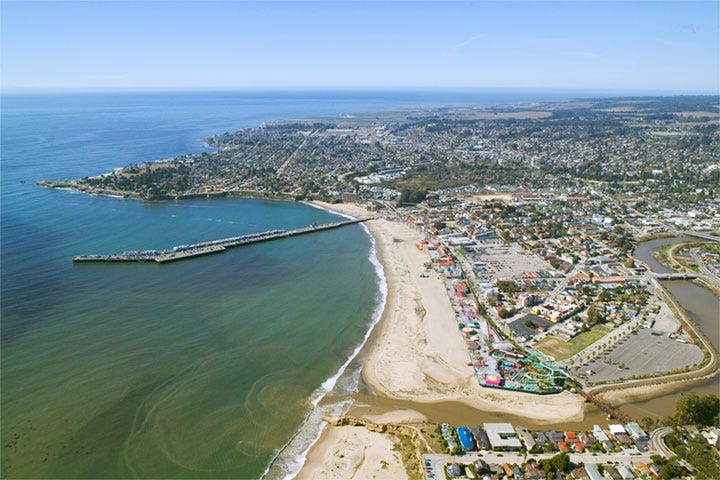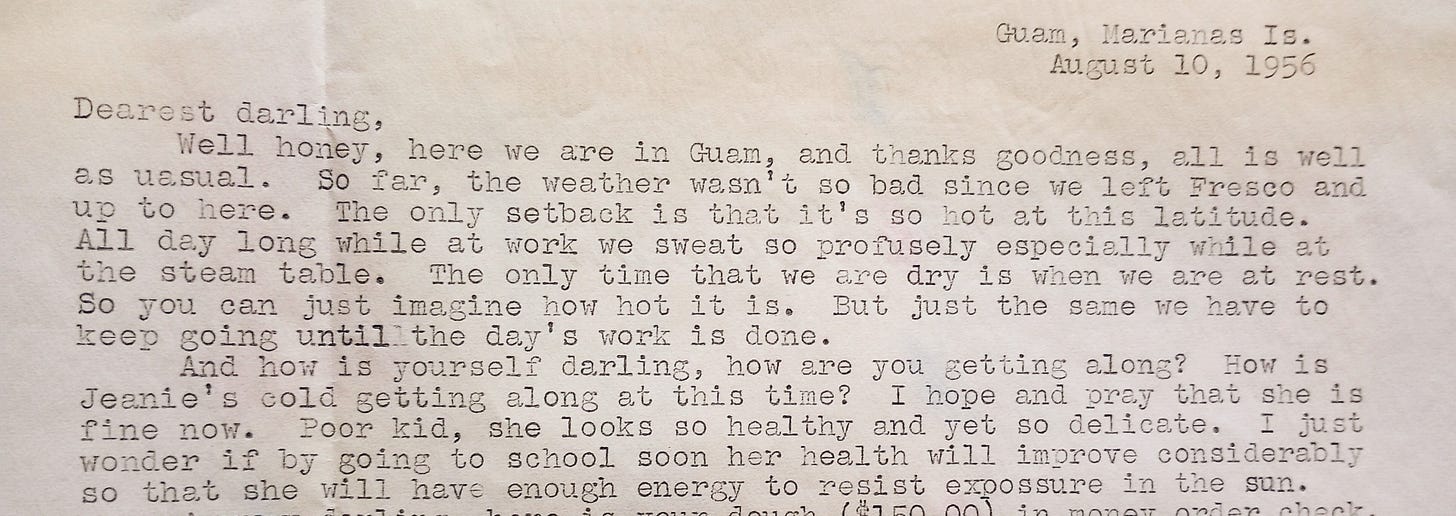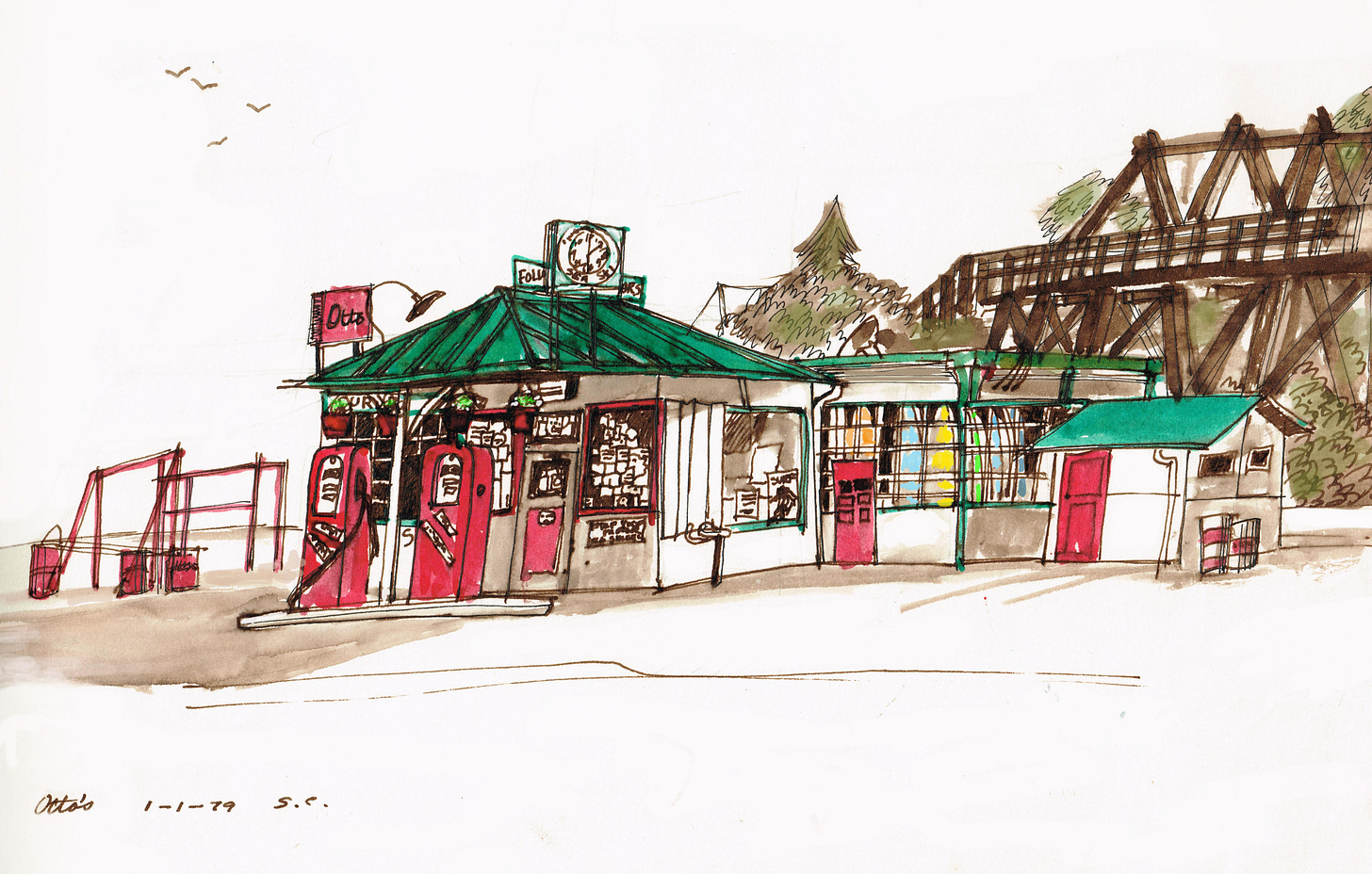Surf City Tomboy
No. 196: Santa Cruz memories, beach town sketches, artist resources, Art Prof., Renato Orara, Susan Choi, Daniel Brown, Firelei Báez, Ruth Tabancay, Jimi Hendrix, & Brian Wilson
THEN & NOW
My birthplace, San Francisco, was christened the “cool grey city of love” by poet George Sterling,1 but my mother and I experienced a climate change when we moved 80 miles south to Santa Cruz, a beach town that had been a tourist magnet for decades. Santa Cruz had the benefits of Central California’s sunny weather, and its position at the northern end of the Bay sheltered us from the worst of the coastal fog, which is such a fixture in San Francisco that they have nicknamed it “Karl.” Towns on the southern end of Monterey Bay have a foggy climate similar to that of San Francisco.
When I was old enough to walk or bike to the cliffs in Santa Cruz (from where I could occasionally see towns and hills on the other side of Monterey Bay), I would frequently see a “river” of fog streaming parallel down the coast, but mysteriously staying offshore. Pelicans would “ride” the stream from the Moss Landing nesting area to their Santa Cruz fishing grounds; locals would gather on the cliffs to watch them plunge into the sea and emerge with beaks and pouches full of anchovies. The river of fog would miss Santa Cruz, but make direct hits on Moss Landing and Monterey.

With such pleasant weather, it’s strange that the move from San Francisco to Santa Cruz seemed to have triggered something in my body. Early on, I started to suffer from allergies. I came down with impetigo, then later contracted pneumonia that was serious enough to require my hospitalization. Later, I came down with chronic asthma. Fortunately, with the advent of new inhaled medications in the late 1950s-1960s, the asthma has remained manageable.
I have previously speculated that the health problems may have originated in my Westside neighborhood. There were few trees there, but plenty of dust, since we arrived while the streets were still being graded for asphalt, sidewalks, and sewers—a process that seemed to take years. Several of the factories near our house emitted fumes and other waste that may have been toxic. My hypersensitivity could have genetic sources, but neither of my parents suffered from allergies.
In his letter of August 10, 1956, my dad referred to me as “delicate” despite looking healthy. It seems odd to me that he—who had grown up in the tropics—saw “exposure to the sun” as something I should “resist”:
The funny thing is that—despite my hospitalization for pneumonia; despite measles, impetigo, tonsillitis, and perhaps more than the usual number of childhood colds and allergic reactions—I remember myself as an active and even tomboyish girl.2 I see myself always running around, exploring places I was supposed to stay away from, climbing trees, playing at “war” in the fields with other kids, and roller skating and bicycling around the neighborhood.
I suspect that I blocked out a lot of the “sick” episodes so that I could just get on with being a kid.
Yes, I do remember crying while surrounded by nurses and doctors in a hospital emergency room, and later waking up in an oxygen tent—a tent that followed me to my bedroom.3 I remember recuperating from hives, asthma, and colds that were probably hayfever. I remember, too, all the various inhalants and pills, and bottles of “cherry-flavored,” icky-tasting medicines.
As I read my parents’ letters, and how they perceived me, their only child, I can feel my perceptions of childhood shifting. As a much older person with health challenges connected to those that I experienced as a youngster, it’s now not so easy to block out those memories of illness.
ART
In the 1970s I started to do some urban sketching, and drew images of familiar Santa Cruz “beach town” locations:

RABBIT HOLE
Artist Resources
I recently posted about the California Digital Newspaper Collection in the Commonwealth Cafe section.
If you’re an artist in Tucson and southern Arizona, consider applying for an ARPA Grant. You have until September to apply!
Palenke Arts is a multicultural arts organization whose mission is to educate, inspire, and transform the community of Seaside [California] through the arts.
Saritaan: Preserving Filipino Migration Stories Across Oceans and Generations. This new UC Santa Cruz initiative called Saritaan—meaning “to talk story” in Ilokano—is preserving the untold migration stories of Filipino families.
Are you sad because you got turned down for a grant that you worked hard for? Now you’re fully prepared to go for the next grant. Art Prof. reports on receiving an artist grant rejection, and preparing for what’s next. Check out the Art Prof. website, which has a wealth of resources for artists:
Philippine artist Renato Orara’s quantum entanglement:
Novelist Susan Choi on powering through a first draft (LitHub).
Form: A short-form artist substack by Daniel Brown, with the focus on form and how creativity shapes our daily lives.
The art of Firelei Báez defies classification.
Meet the UCSF Library Artist in Residence, Dr. Ruth Tabancay. Ruth’s mom was one of my Filipino “aunties” and my mom’s friend, back in the day. Tabancay’s exhibit, Fossil Fuels: How Humans Commodified a Natural Resource, is opening on June 26, at UCSF, Parnassus Living Room, 4 pm.
An innate love of science led her to major in Bacteriology in college which would form the basis of her early artwork. Then, her concepts centered around microscopy and scale using the textile techniques – crochet and knitting – that she taught herself as a child as well as the scanning electron microscope, computerized Jacquard loom, and textile techniques such as felting, embroidery, and material-based art.
Below is a video from a previous exhibit by Ruth Tabancay:
SOUNDINGS
I’m in a nostalgic mood for music of the 1960s-70s, so here are two artists who, with their bands, changed the music scene of that period forever:
Jimi Hendrix performs Bob Dylan’s apocalyptic song, “All Along the Watchtower,” which really resonates for me during this season of unrest:
“No reason to get excited,” the thief, he kindly spoke
There are many here among us who feel that life is but a joke,
But you and I, we’ve been through that, and this is not our fate
So let us not talk falsely now, the hour’s getting late . . .4
Rest in peace, Brian Wilson. I grew up in Surf City (Santa Cruz), California, and the Beach Boys’ harmonies provided the soundtrack to my youth. 5
My gratitude goes to everyone who reads Eulipion Outpost regularly, and especially to those who have subscribed or donated on my Ko-fi page to support my efforts.
My ongoing appreciation goes to the Mysterious M. for his excellent editing skills.
Website and blog: Jeanvengua.com
A Crooked Mile (a blog)
CommonwealthCafe (Filipino American & AAPI history and print culture)
Eulipion Outpost is a reader-supported publication. To receive new posts and support my work, consider becoming a free or paid subscriber.
Called the “King of Bohemia,” George Sterling was also a cad and a bounder (as they said back in the day), who ruined the lives of several women and himself while living in Carmel, California.
I seem to remember Mom telling me not to be such a tomboy.
I still wonder if that memory was a dream, or if that oxygen tent was really required for me at home. It must’ve been expensive!
Written by Bob Dylan, Copyright © 1968 by Dwarf Music; renewed 1996 by Dwarf Music
Songwriters: Brian Douglas Wilson / Mike E. Love. Good Vibrations lyrics © Universal Music Publishing Group








